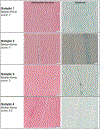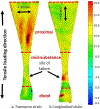Mechanical and strain behaviour of human Achilles tendon during in vitro testing to failure
- PMID: 35446434
- PMCID: PMC9286485
- DOI: 10.22203/eCM.v043a12
Mechanical and strain behaviour of human Achilles tendon during in vitro testing to failure
Abstract
The Achilles tendon is the strongest tendon in the human body but its mechanical behaviour during failure has been little studied and the basis of its high tensile strength has not been elucidated in detail. In the present study, healthy, human, Achilles tendons were loaded to failure in an anatomically authentic fashion while the local deformation and strains were studied in real time, with very high precision, using digital image correlation (DIC). The values determined for the strength of the Achilles tendon were at the high end of those reported in the literature, consistent with the absence of a pre-existing tendinopathy in the samples, as determined by careful gross inspection and histology. Early in the loading cycle, the proximal region of the tendon accumulated high lateral strains while longitudinal strains remained low. However, immediately before rupture, the mid-substance of the Achilles tendon, its weakest part, started to show high longitudinal strains. These new insights advance the understanding of the mechanical behaviour of tendons as they are stretched to failure.
Figures







References
-
- Ganestam A, Kallemose T, Troelsen A, Barfod KW (2016) Increasing incidence of acute Achilles tendon rupture and a noticeable decline in surgical treatment from 1994 to 2013. A nationwide registry study of 33,160 patients. Knee Surg Sports Traumatol Arthrosc 24: 3730–3737. - PubMed
-
- Gatt R, Vella Wood M, Gatt A, Zarb F, Formosa C, Azzopardi KM, Casha A, Agius TP, Schembri-Wismayer P, Attard L, Chockalingam N, Grima JN (2015) Negative Poisson’s ratios in tendons: an unexpected mechanical response. Acta Biomater 24: 201–208. - PubMed
Publication types
MeSH terms
Grants and funding
LinkOut - more resources
Full Text Sources
Medical

